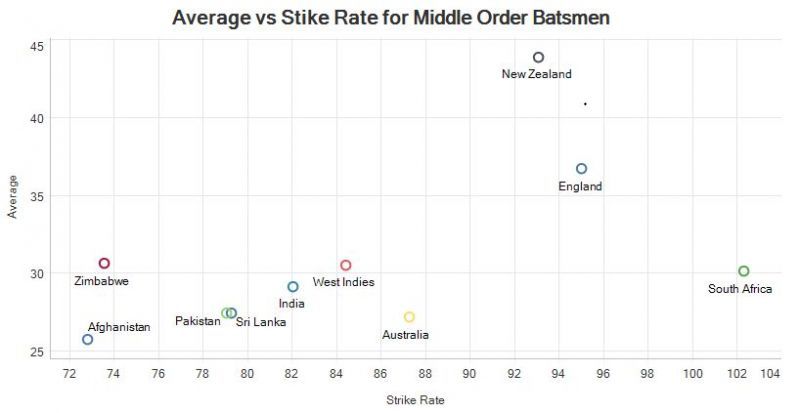
Decoding India's Middle Order Failures
India's middle order worries in ODIs are not hidden from anyone. At the beginning of Asia Cup, Rohit Sharma the stand-in captain remarked that middle order spots at number 4 and 6 were up for grabs.
Pandya at number 7 also hasn't been able to have the influence on matches that the team management would have liked. With the World Cup less than 9 months away, the situation is far from ideal for the Indian Cricket Team. Quantifying how the Indian middle order has been performing in comparison to their contemporaries, it is quite clear that India is struggling.
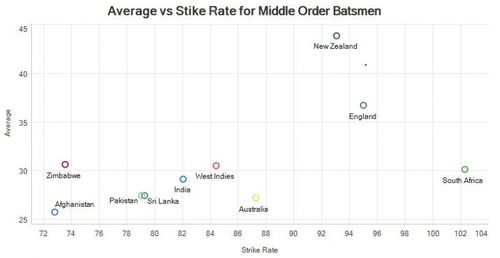
We see that Indian middle order is tottering along with the lower ranked teams with New Zealand and England clearly ahead of the pack with much higher strike rates and averages. But, even though the Indian middle order scores at a measly average of 29.11 striking at 82.06 as compared to New Zealand's 93.06 or England's 95.02, India has been able to do well and are ranked number 2 in the ODI rankings.
This is where the prolific Indian top order of Rohit Sharma, Shikhar Dhawan and Virat Kohli come into play. The following chart shows how much each team depends on their top order. We calculate the difference between the averages of the top order and middle order batsman. The higher the value, more the dependence of scoring on the top order.
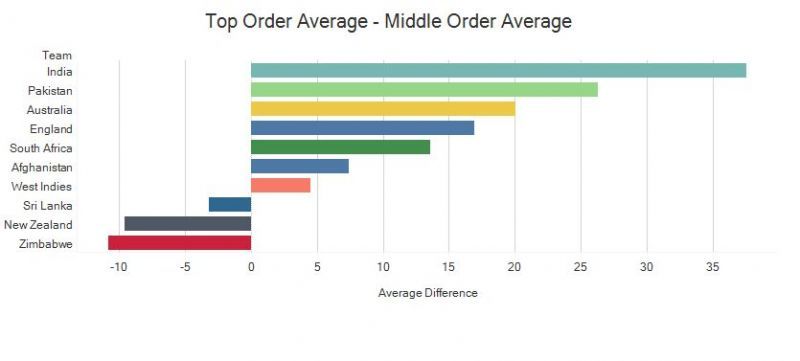
Indian top order clearly takes the cake with a gigantic average difference of 37.53. Number 1 ranked England have a mild difference of 16.92 indicating a much more balanced distribution of runs among the batsmen whereas the negative average difference for number 3 ranked New Zealand points to a shaky top order.
So, why is it the case that the Indian team once known for its much superior batting prowess is struggling to put up 6-7 good batsmen in One-Day Internationals? Why are the batsmen not able to translate their sublime form from IPL and Vijay Hazare (Domestic One Day tournament) matches to the international stage? Or has the talent in the domestic structure decreased or the temperament gone for a toss? The quality of shots in the IPL and temperament of debutants like Hanuma Vihari certainly wouldn't suggest so. So, what is it?
The data suggest that the very thing that invariably saves the day for Indian batting might be the one sinking the middle order, the top order. The chart shows the number of balls faced per match by different middle orders in the last one year.
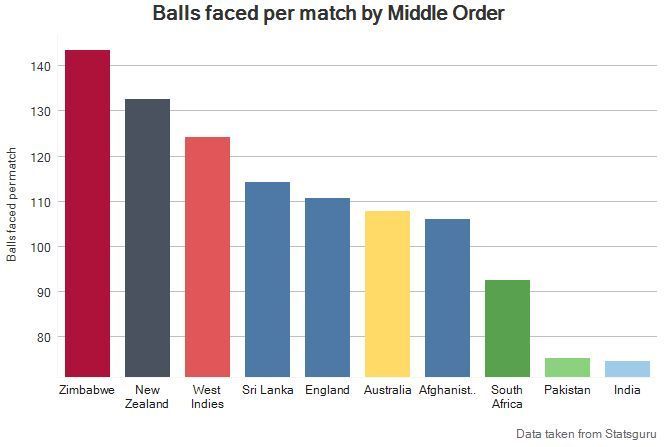
India performs the poorest on the metric with Indian middle order facing an average of 74 balls a match, i.e., they get the least time to bat among all teams. This means that the Indian number 4 comes out to bat on an average in the 38th over as compared to England's number 4 who comes out in the 32nd over. Now, this difference of 36 balls might not seem large but the position of these balls in a 50 overs innings create a big impact.
This allows even the England batsmen who play with a gung-ho approach a little more time to settle in so that they can go bonkers later on. Kedar Jadhav hinted after the first match against Pakistan in Asia Cup that the team management was aware of the problem. When asked about the opportunities in absence of Kohli, he remarked," I have batted 25 times out of the 42 matches I've played, even there, I would've got only 10-15 balls at least 10 times."
The question then may arise, why worry if the top order is doing well and the team is winning matches? Unfortunately, we don't have to look too far for the answer. In high-pressure matches like the final vs Pakistan in the 2017 Champions Trophy or the semi-final vs Australia in 2015 World Cup where India crumbled to 33/3 after 9 overs and 3/91 after 18 overs, the middle order didn't have the experience of playing the long innings and bailing the team out of trouble.
After being hardly required throughout the tournaments, when called upon suddenly in a knockout game, the middle order expectedly failed. Further, as evinced by the average vs strike rate data it has become almost a norm in recent times that India hasn't been able to capitalise on their strong starts to put up totals of 330+ which will be required on the flat tracks of England.
So, what must India do to avoid the same in 9 months time in the world cup? For starters, in largely inconsequential matches like the upcoming ones vs Windies, both openers could take a more aggressive approach in the first 10 overs placing a lesser value on their wicket so that either the scoring rate goes up or the middle order gets some opportunity. Another approach could be to rest the top order players like Kohli was for the Asia Cup and bat each batsman higher up the order.
Another left-field choice could be to try the highly talented KL Rahul at 3 and slide Kohli to 4 in the matches leading up to the world cup. This will allow Rahul opportunities in the XI and an in-form player like Kohli to play in the middle order who you would expect to do well in most situations. But, is it worth the risk to dislodge Kohli from 3?
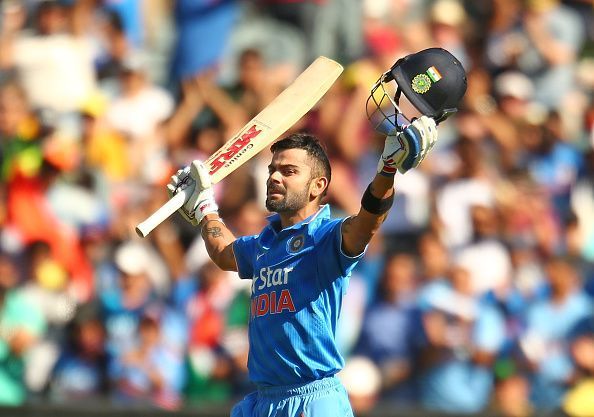
*- For the sake of the discussion, batsmen coming in at number 4 to 7 have been considered a part of the middle order whereas batsman from 1 to 3 is considered a part of the top order. All data is for the last one year up to the first day of Super 4 matches in the ongoing Asia Cup .